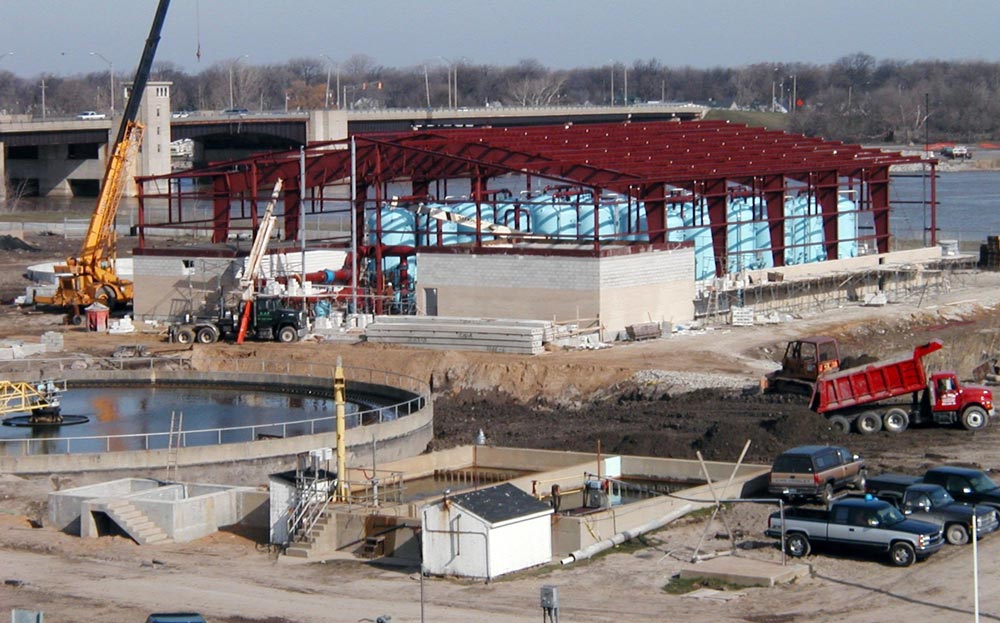
The City of Bay City was faced with the challenge of meeting discharge limitations with an aging wastewater treatment facility, part of which was constructed in the 1950s. The City also had to meet a limitation for the toxic compound polychlorinated biphenyl (PCB), which frequently is found in the City’s influent and sometimes in the effluent. With the NPDES permit limitation for PCB less than detection, new facilities were required to meet a consent judgment stipulation that the City provide the best available treatment for PCBs. Hubbell, Roth & Clark, Inc. conducted master planning and pilot studies to evaluate the existing wastewater treatment facilities and ultimately designed a direct carbon filtration system which received a US patent. These cost-effective renovations allow the facility to continue to meet NPDES limitations for conventional pollutants and new facilities to meet the stringent PCB limitation.
The improvements to the Bay City WWTP included new influent pumps, primary settling tank mechanisms, secondary clarifier mechanisms, trickling filter distributor arms, new sludge disposal facilities to dewater and store solids for disposal to landfill, new laboratory and administrative building, new ultraviolet disinfection system, improvements to the City’s existing five combined sewer overflow retention treatment basins, and the tertiary granular activated carbon filtration system for PCB removal. The plant control system was completely replaced with a Supervisory Control and Data Acquisition (SCADA) System with fiber optic cable to ensure that process control can be maintained during storm conditions.
The new ultraviolet disinfection system is located immediately downstream of the filter clearwell within the tertiary filter building. The open-channel system replaced the existing ton cylinder chlorine gas process. The UV bulbs are maintained with a mechanical cleaning operation.
To obtain funding for construction of the needed improvements, HRC prepared a Project Plan to obtain State Revolving Fund loan monies. The Project Plan met all of the requirements of the Michigan Department of Environmental Quality and allowed the City to implement the project with low interest loan funds.
One of the greatest project challenges was to replace all of the existing mechanical and electrical equipment (including modifying the electrical service from 240 volt to 480 volt) while keeping the plant in-service. HRC converted the existing 240 volt distribution system at several buildings to 480 volts, due to the age of the equipment and to be consistent with the distribution voltage at the newer areas of the plant. A new 2,400 volt power distribution system was provided throughout the plant and provided redundant feeds to each major building. This required unique construction sequencing planning by HRC. The sequencing was successful because the plant met permit conditions during construction and is now exceeding expectations for water quality.
Variable Frequency Drives
Variable Frequency Drives (VFDs) were incorporated in the electrical and process design for many larger new and replacement pump motors to enable variable speed pumping as required to match varying plant flow conditions. Outdated VFDs and eddy current couplings were replaced with clean power VFDs, including constant speed bypass starters, for the 244 HP influent effluent pumps and 100 HP primary influent pumps. Similar VFDs were provided for new 200 HP tertiary filter pumps.
The improvements to the Bay City WWTP included new influent pumps, primary settling tank mechanisms, secondary clarifier mechanisms, trickling filter distributor arms, new sludge disposal facilities to dewater and store solids for disposal to landfill, new laboratory and administrative building, new ultraviolet disinfection system, improvements to the City’s existing five combined sewer overflow retention treatment basins, and the tertiary granular activated carbon filtration system for PCB removal. The plant control system was completely replaced with a Supervisory Control and Data Acquisition (SCADA) System with fiber optic cable to ensure that process control can be maintained during storm conditions.
Additional work on the site included the excavation, removal and disposal of PCB contaminated materials from the original site ash lagoons. This work included excavation and disposal of the contaminated materials.
The facility treats an average daily flow of approximately 7 million gallons per day, with sustained peak flows of 18 MGD resulting from the dewatering operations of the City’s five retention treatment basins.
HRC assisted the City with obtaining low interest MDEQ State Revolving Loan Funds.

